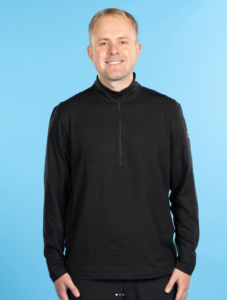OMSI’s Synthetic Rink Isn’t Quite Ice-Skating, But It’s a Fun Novelty

Our ice-skating correspondent on the scene at OMSI’s synthetic rink, as captured by a kind stranger.
Normally, contact with something that’s internally self-lubricating is a little less wholesome than a trip to the Oregon Museum of Science & Industry. But that autolubrication and “excellent balance between glide and grip” are among the main marketing points for Glice, a Swiss maker of plastic tiles that behave like skating ice. They’re the foundation of OMSI’s pop-up seasonal indoor Glice rink, found at the center of its holiday light–festooned auditorium, with hot cocoa and nine-inch-diameter cookies for sale just outside.
Ice rinks, even indoor ones, are generally made with real-deal frozen water, which is why most skating trips require puffy jackets and mittens; however, synthetic ice like Polyglide or Glice have grown in popularity, demanding less energy, equipment, and temperature control to operate. As with other internally self-lubricating spaces, the simulation can’t top the real thing. But at $9 for a 25-minute session, OMSI’s rink, open till New Year’s, can be a fun diversion, either on your own or with a friend or two. Add more people or strangers, though, and things might get a little complicated. There’s some built-in crowd control: Just over a dozen timed tickets are available at a time. Most weekend sessions are already sold out, but in my midweek, midday time slot there was only one other skater.

OMSI offers four whale-shaped helpers on a first-come, first-served basis.
Even when you have the ice to yourself, you can tell the space works best for a tinier demographic. The rink is only 20 feet by 40 feet, so kids who haven’t skated much (and adults still figuring out their balance on skates) may appreciate the little rink as a kind and gentle introduction. As at other rinks, novices can hold the railing (which would be a reach for toddlers, but the minimum age at the OMSI rink is 5) all the way around. Also as at other rinks, the surface is less level around the edge than in the middle.
I’m not a rail holder, since I’ve been skating since preschool, and while I enjoyed the wee workout, I didn’t mind when the 25-minute timer dinged for the end of the session. I couldn’t do much other than go in a small circle. Later, when I showed friends a video of me doing a few laps, they joked that I looked like a tiger in a cage that’s too small for me, or a ballerina trapped in a jewelry box. As for the “ice,” after an initial adjustment—like when you put on or take off high heels, switch to a new pair of glasses, or need a moment to orient yourself when you realize the layout of the Target you’re in is different from your regular Target—the basics of forward and backward skating start to feel pretty normal. But any edgework or lateral motions run into trouble with the increased friction. If you take a spill, at least you won’t slide as far (not that there’s far to slide). My one fall came when I attempted a bit of a spin by rotating and pulling my skates together. OMSI prohibits tricks on the ice, so if this counted as a trick then I guess the bruise on my knee is my punishment.

The little plastic Glice bits that cling to the skate blades look like ice shavings, but they’re totally dry.
While another selling point of Glice is that it works with any kind of skates, at OMSI you must use the provided ones, hockey skates with a single ski-boot-type fastener at the top. With no way to tighten around the forefoot or midfoot, a skater doesn’t have as much control as with a laced skate or one with more fasteners, so that could also be a factor in things feeling just a little different. At the end of the session, my skate blades were covered not with ice but with tiny bits of white plastic. It was also all over my clothes from the fall, and hard to brush off. Unlike at a regular ice rink, though, nothing was wet, which will keep OMSI’s auditorium from smelling like a musty hockey locker room.
Bucking the convention of every ice and roller rink I’ve ever been to, OMSI asks skaters to go clockwise. More than the ice not being ice, the space being warm and not cold, and the sense that I’d just eaten the cake in Alice in Wonderland and grown so everything around me was much smaller, it was the directional change that seemed to require a rewiring of my brain. I wondered if OMSI, with its educational mission, wanted me to question my tacit acceptance of right-footed dominance and force me to practice my left-footed crossovers. Maybe it was a geography lesson about how things are different in countries where they drive on the left? Later I looked it up and learned skaters go counterclockwise in those places, too (though people say “anti-clockwise” in the UK and Australia).

No hats or mittens are needed at OMSI’s indoor rink.
When I asked, an OMSI rep said the choice had no ulterior motive: They wanted to pick one direction for safety reasons, and clockwise just seemed clear and easy. But thinking about rotation and Australia had already sent me down a rabbit hole about the claim that toilets drain the other direction in the Southern Hemisphere, and I was deep in scientific articles debunking that myth, explaining that bathroom sinks and toilets are too small for their contents to be influenced by the Coriolis effect.
OMSI’s rink, a great match for a new little skater who doesn’t want to worry about cold fingers and an intriguing idea when it comes to winter sports on a warmer planet, might not be meant for me. Yet there I was, having a full-on learning experience at the museum—not about internal self-lubrication (for the record, I do have some knowledge of that already) and high-density polymers, but learning nonetheless.
Share this content:















Post Comment